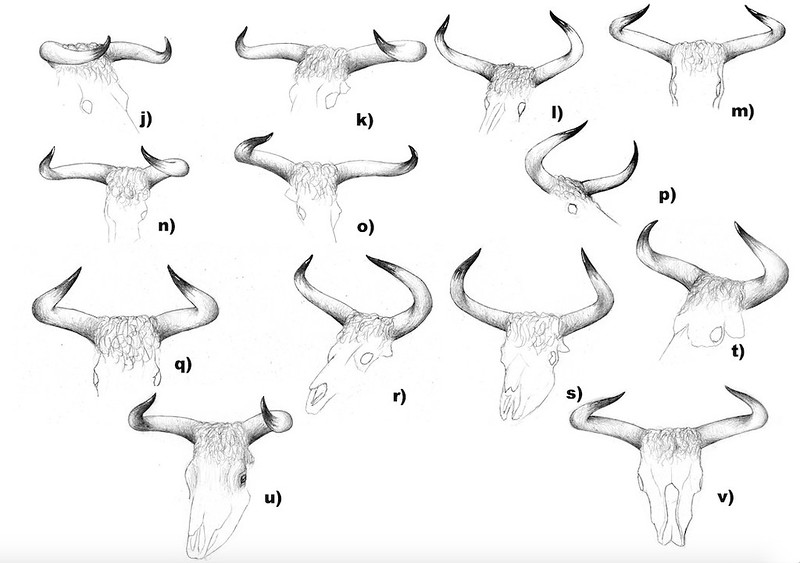I described the horns of the aurochs in a 2013 post already. The basic curvature of the horns was always the same in the aurochs, but there was considerable variation on the actual length, thickness, shape and orientation of the horns within a certain range.
I tried to capture this variation on two drawings in 2015 where I reconstructed the horn sheaths onto 22 skulls in order to see what the horns might have looked like in life. I am going to repost them down below. We cannot be absolutely sure on the life appearance of the sheaths as there was no general rule of thumb of how much the sheath adds to length and thickness of the horn cure. There was quite some variation (van Vuure, 2005). So the reconstructions down below are an approximation.
For the identity of the skulls, go to the 2015 post.
Recently I did some more sketches, also including skulls that I already reconstructed in 2015:
From left to right top down: Berlin skull, a skull of a location unknown to me, the Cambridge cow, Gramsberger Museum skull, Himmelev specimen, Horsholm specimen, a cow skull from Italy, the Stuttgart skull and the Vig bull.
Having reconstructed about 30 specimen, I think this is a fairly representative sample for the variation of the horns of the European subspecies Bos primigenius primigenius.
Orientation relative to the skull
The literature states that the orientation of the horns relative to the skull varied from 50 to 70° (van Vuure, 2005). However, having had a look at so many skulls I find that the range is actually larger. The oldest aurochs skull which was discovered in 2014 had an orientation of 40°. The Vig specimen has an orientation of 90°, and the Horsholm specimen probably an even larger angle.
Geographic variation
I see some sort of geographic correlation in the variation of the horn types. For example, the more Southern the skulls, the sharper is the angle between the horns and the snout. The more Northern and Eastern, the higher is the orientation of the horns. You see that very clearly in the Kiev specimen and the Eastern Asian aurochs Bos primigenius suxianensis (yes, apparently Eastern Asian aurochs were a distinct subspecies, more on that in an upcoming post). Small-horned aurochs seemingly only appeared in Northern Europe, all other locations (Southern Europe, Africa, Asia) had pretty large-horned aurochs.




The horns on the last illustration appear somewhat filigree to me,
ReplyDeleteexept top left one.
On the other two illustrations they look more naturally to me.